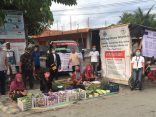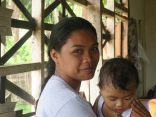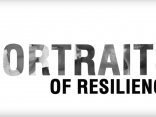by Darwin Masacupan
In photo: One of Mag-aso’s livelihood groups among the corn plants they cultivated. (Mavic Relayson / ECHO2 Consortium)
It was so bright that day, and not just because of the noontime sun directly over our heads. It was another thing entirely: the dreams shared by the people of Barangay. Mag-aso in La Paz, Leyte.
by Darwin Masacupan
In photo: One of Mag-aso’s livelihood groups among the corn plants they cultivated. (Mavic Relayson / ECHO2 Consortium)
It was so bright that day, and not just because of the noontime sun directly over our heads. It was another thing entirely: the dreams shared by the people of Barangay. Mag-aso in La Paz, Leyte.
Mag-aso is an hour and a half drive from Tacloban City proper. Access is through a rough road, which becomes slippery and muddy when it rains. Majority of the population depend on agriculture for their living.
Elvira Andrade, a livelihood group leader in the barangay, shared, “Before, we really did not worry about feeding our families. We had abundant abaca and coconut trees from which we derive our income. We even had time to play bingo. Yolanda changed all that.”
Indeed it did. Agina Gabreno, barangay secretary, said that “We thought it was the end of the world. The winds and the rains terrified us. We cannot see our surroundings. Our families and possessions were all drenched. We were cold and hungry.”
With most of the abaca and coconut trees destroyed, the community faced a great challenge. But these people were not about to give up. Immediately after the storm, they set upon clearing roads so that supplies can get to them. They also redistributed and rationed what little rice and bananas they gathered and received.
ACCORD and CARE, with the support of the European Commission's Humanitarian Aid and Civil Protection department (ECHO) and the Dutch Cooperating Aid Agencies (SHO), built on this display of bayanihan (mutual aid) with their shelter assistance.
Neighbors helped each other and prioritized rebuilding the houses of the most vulnerable such as the elderly and those with disabilities. They did not only receive shelter repair kits and cash support but also technical assistance in the form of trainings on Build Back Safer techniques. Initial trainings on community-based disaster risk management (CBDRM) also broadened their understanding on how socio-economic and structural conditions render them vulnerable to disasters like Yolanda.
For the livelihood recovery phase, ACCORD and CARE helped the people organize themselves into livelihood groups. The list of income-generating activities they came up with included raising livestock, sari-sari stores, and planting crops. Many of them, for the first time in their lives, picked up their tools and cultivated crops they were not really used to: cassava, gabi, mani, and corn.
This diversification of livelihoods and crops is part of ACCORD and CARE’s strategy to strengthen community resilience. According to Dolly Odo, treasurer of the livelihood group, “We were encouraged to plant different crops in our backyards and idle lots so that we can have an additional source of food.” By having a wide variety of activities, the community can be self-reliant especially during emergencies.
But the community wanted to go big or go home. Odo shares, “If we only utilized the cash assistance we received in individual activities, we cannot scale up. We want something bigger.” It was then that all 148 of their barangay's beneficiaries decided to allot PhP 3,500 (around $81) each from the cash grants they received. It was with this amount that they set upon the construction of a cornmill for the barangay.
Their neighboring barangays ask, “Why corn? And why a cornmill?” Andrade replied, “It only takes 3 months to harvest corn, and we are able to make rice from it. A cornmill here in our barangays would mean that we, along with other barangays in La Paz, would not have to go to another municipality to have our grains processed.”
But building a cornmill is not easy. The men have had to commit a set amount of time to help build the cornmill, despite also having to earn their livelihoods working the fields in the area. The women also contribute by cooking the food, clearing the area, and devising budgets to guide project implementation. Andrade proudly shares that they have placed their order for the machinery and expect to open the cornmill this October.
Their planned cornmill is different from other businesses, where profits are divided among the members every month. “The earnings will not go back to us. It will be invested in the bank, and will go into the future purchase of a solar drier, and eventually a rice mill,” she says.
The people of Mag-aso do not have it easy. Life remains hard. Incomes are low. Most of them are tenants, with just a few families owning most of the productive land in the area. This would clearly be a challenge to recovery going forward.
But still, one cannot help but be proud of such strong women, who make things happen. Not content with merely standing behind their men, they have stepped up to the challenge brought by Yolanda. Now working hard from sunrise to sunset on their crops instead of idly chit-chatting, they still seem to appreciate the change in their community.
Andrade is nothing but thankful. “We never dreamed of such things before. Thank you to everyone who believed in us and made us believe that we can scale up our dreams.”




